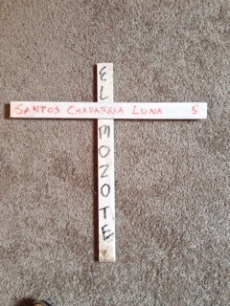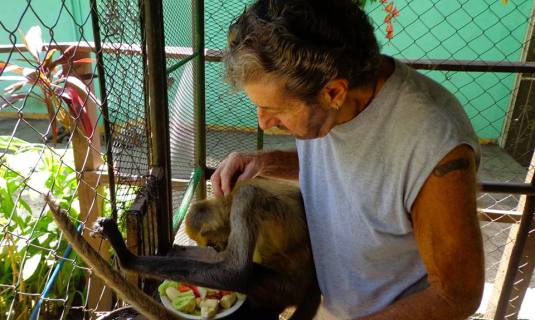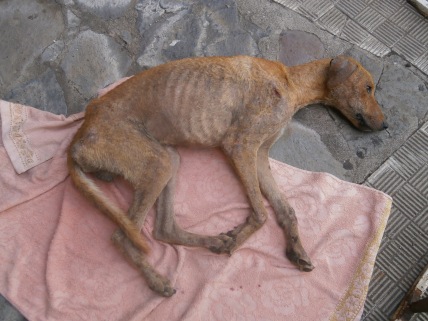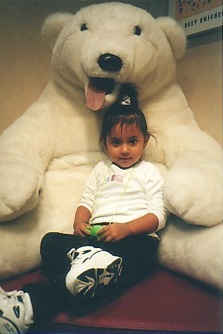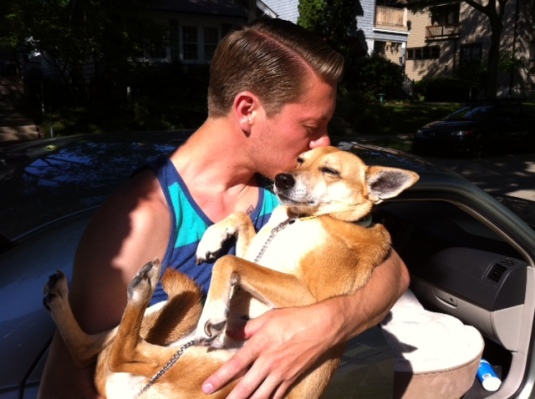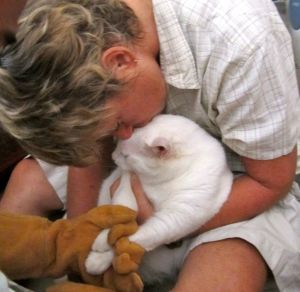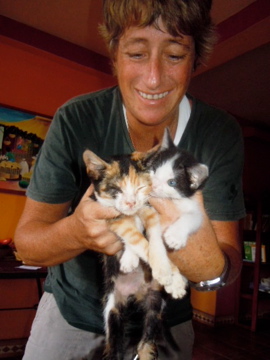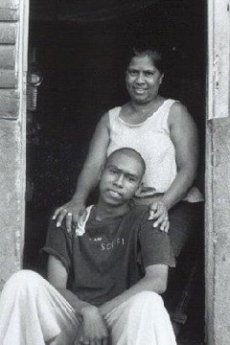….. I might have been the only vet in my hometown of Williamsport, PA.
I’m not sure I even knew the meaning of “veterinarian.” But I set up my little clinic on our family’s back porch for my patients: my kitten Taffy and our neighbor’s calico cat and puppy.
My focus wasn’t healing animals but rather making sure they didn’t get sick in the first place. That’s why force-feeding cooked carrots to my patients was always first on my daily agenda.
I outfitted the makeshift ward with my doll furniture, at great personal sacrifice I might add. There were two cribs, a small table with stools in case my patients wanted to have a spot of tea (though none ever did), and a high chair where I would sequester my bribed patients and plead with them to taste the mashed carrots.
To add a touch of professionalism to my caregiving, I pinned a folded Kleenex across my head to pass myself off as a nurse. But that didn’t make the carrots palatable either.
A lot of time went into coaxing our neighbor’s calico to lie down in the crib and stay under the blanket. That would last five seconds tops before she’d escape back to her home next door. It was difficult for me to accept this lack of appreciation.
In spite of the little critters’ bad attitude, I clung to my larger vision of some day having a major vet hospital that would also accommodate horses. Every seven-year old kid loves horses.
It was two neighborhood brothers, wicked as Satan himself, who smashed my dream. They literally put the final nail in the coffin of my sweet kitten Taffy.
They took Taffy behind their house and beat her with a ketchup bottle, smashing her little skull. This was traumatic enough for a kid my age. But they extended their malice by leading me to the killing ground to show off my dead kitten.
Revenge is difficult for one seven-year old against two teenage heartless brutes. But I screamed at them as loud as I could: “ I hope God punishes you! I hope you both get POLIO!”
They laughed at me.
Within a year and before the Salk vaccine was developed, both boys were stricken with polio. I find myself still hoping that God didn’t take me at my word. I would have preferred a bad case of poison ivy or maybe hemorrhoids as due punishment. But I won’t question God. And when you really think about it, polio isn’t quite as bad as a crushed skull.
So without my model patient Taffy, I closed our town’s only pet clinic and went back to being Dale Evans, queen of the cowgirls, with the neighbor kids who preferred Wild West drama.
In spite of my clinic’s short existence, animals occupied a place in my life long after my dream was dismantled.
Soon after it’s closing, my Dad, always amused by the unusual, presented my brother and me with Stinky the Skunk. A barber friend, a man he called “Drag Ass” because of his short stature, had tired of its novelty in his shop, so he gave Stinky to Dad to give to us.
Stinky was definitely a misnomer since he had already been “deodorized. He was the hit of our household until he bit my Dad’s thumb. Then his popularity took a nosedive and Stinky was gifted to another barber.
Later Jasper the squirrel monkey, acquired on a Florida vacation, lived with us until he swung one too many times in our neighbor’s trees.
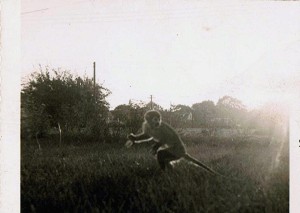
Jasper the squirrel monkey
On that fateful day, he swung from limb to limb above their picnic table where guests were feasting. Wanting to join the party, Jasper dropped his furry self into a big bowl of potato salad and hopped from plate to plate, carrying off as much food as his scrawny arms could hold.
The frightened guests screamed and scattered, perhaps believing that a gorilla wasn’t too far behind.
Jasper was sent back to Florida as fast as we could arrange his getaway before the police could find him and haul him away.
Years later, I went off to Penn State University and lived in what had once been a male dormitory. I brought my goldfish to the campus to live with me. They swam in luxury in the urinals since we females weren’t using them — except for the one reserved for rinsing our panty hose.
But their lives were snuffed out when a new member of the Squeaky Cleaning Squad mistakenly flushed them to the big river in the sky, not realizing that American Standard appliances could have multiple functions, condos for pet fish being one of them.
Some years later, Felicia came into my married life to live with us for more than 10 years. She was a sweet, scared pup that my husband and I adopted from Animal Friends for our daughters, Cyndy and Jennifer.
Felicia died years after the marriage died, but she brought happiness into every day that she was with us.
A few years later came a starved, dazed terrier found wandering in a nearby park. She became Farrah, as in Fawcett, because of her thick, wavy fur.
I was then living with a man who loved Farrah as much as I did. When we dissolved our relationship, we arranged for dual custody. Two wonderful weeks with me; two crappy weeks with him. It worked well until Farrah developed an untreatable tumor and was euthanized shortly after.
A year later The Duke entered my life. I discovered him while producing a TV feature for a Pittsburgh station. Just a heartbeat away from starvation, he was tied in a dirt yard with a short rope nearly embedded in his neck. He was trying to dig in rock-hard soil, looking for anything that resembled sustenance.
The owners’ house appeared empty; no one answered the door. A stroke of luck for us and for the dog. The cameraman carried the living skeleton to the car. We rejoiced in our successful dog-napping as we headed for the Animal Friends Shelter where the dog would be treated.
His patchwork of skin and hair along with bones outlined through his flesh didn’t put him in the spotlight for adoption. But to me, he was a most beautiful soul.
And so The Duke became mine.
We had a fun-filled life together, joined by Leo, a lionized kitten rescued from the streets, until 1996 when I left Pittsburgh to begin my Peace Corps training in Nicaragua.
Leo went to live with one of my daughters where he became the spoiled king that he was meant to be. Duke went to Tampa, Florida, to live with a friend. The plan was that I would be back in two years to bring him home to Pittsburgh again.
But both Duke and Leo passed away before we got that far with our plan.
News from home of their passing was difficult to deal with. I should have been there for them. But in looking back through my 15 years here in Nicaragua, I can fashion my own mental memorial to both of them. Their ashes are at rest in small shiny urns on my bookshelves in Pittsburgh, PA, where they once lounged and drifted off to dream.
In 1996, when I set foot on Nicaraguan soil, veterinary care was sketchy at best. The few vets here made their living by selling animal feed, machetes, and general meds for parasites or fleas. If they treated animals, they were more than likely pigs or cows.
My initial experiences with Granada veterinarians are definitely memorable. New to my Peace Corps community of Granada , I spent a fair amount of time cruising the streets alone, getting acquainted with my new hometown.
One day while walking on a quiet side street I spotted a puppy near a gutter. I thought it was dead, until its eyes blinked. I looked around for someone, anyone, to give some direction. But the puppy and I were alone.
I moved the little body closer to the curb, away from the danger of passing cars and bikes, should one even pass by. Then I took off to look for a veterinarian.
I found a clinic with a handmade sign. I explained the situation to the vet: The puppy is seriously injured. It can’t stand up. Please come with me and help it!
He asked where the puppy was. He would pick up the puppy in the morning to put it on the garbage pile for pick-up the next day.
“No!” Now the tears were welling. “Please go with me to help the puppy. Now!” But he insisted on his garbage pile method. “That’s the way we do things here,” he said without much pity for the puppy or for me. It appeared to be his final offer.
I left, holding back tears as well as information about the puppy’s location.
I searched again for another veterinarian and finally found one in his clinic, selling chicken feed to a farmer.
We drove in his battered truck and found the puppy still breathing but barely. The vet assessed the situation without even touching the little guy. As I had expected, euthanasia was inevitable.
The vet whistled while he prepared the syringe. His casual manner seemed more suited for someone waiting for his turn in the men’s room.
Finally he administered the injections, continuing to whistle while we watched the puppy take its last breath on earth. I was numb. That I remember.
The vet ceremoniously removed his exam gloves and threw them into the gutter near the puppy’s body. His attitude spoke for him: My job here is done. I won the match. I am the champ
I asked how much I owed him.
“Three hundred cordobas,” he said. Nearly $15 American. A lot of money for a Peace Corps volunteer who lives on $240 a month. It didn’t matter. I had the cash and the puppy was no longer frightened or in pain. It wasn’t going to get better than that.
Feeling a kind of peace, I released the rest of my tears without any regard for my one-man audience. But the message of my emotional pain wasn’t connecting with the good doc. He was still more business than veterinarian.
“Okay. Okay. TWO hundred cordobas.”
Unbelievable. He really thought I was crying over the price of his service. The pity that he denied the puppy was given to me. I gave him his reduced payment, and he counted it carefully. Then I watched him drive away.
He left me with an empty syringe and needle thrown in the gutter and the lifeless body of a puppy.
